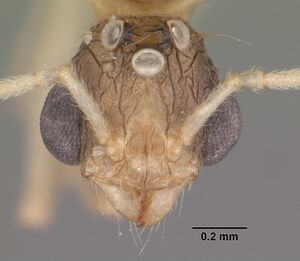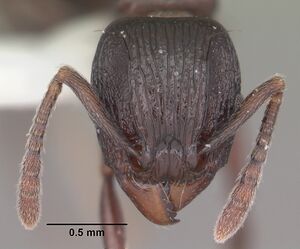Tetramorium severini
| Tetramorium severini | |
|---|---|

| |
| Scientific classification | |
| Kingdom: | Animalia |
| Phylum: | Arthropoda |
| Class: | Insecta |
| Order: | Hymenoptera |
| Family: | Formicidae |
| Subfamily: | Myrmicinae |
| Tribe: | Crematogastrini |
| Genus: | Tetramorium |
| Species group: | severini |
| Species: | T. severini |
| Binomial name | |
| Tetramorium severini (Emery, 1895) | |
Tetramorium severini lives in leaf litter and/or the ground.
Identification
The lone member of the Tetramorium severini species group.
Hita Garcia and Fisher (2014) - Tetramorium severini can be easily distinguished from all other Malagasy Tetramorium by the following character combination: 11-segmented antennae; long and slender mesosoma (LMI 35–37) without distinct margination between lateral and dorsal mesosoma; very long propodeal spines (PSLI 38–43); rounded high nodiform petiolar node; weakly sculptured mesosomal dorsum; completely unsculptured waist segments; very dark brown to black colouration.
As mentioned above, T. severini is the only member of its species group, and a prominent element of the Malagasy Tetramorium fauna. The large body size, very dark colour, very long propodeal spines, reduced sculpture on the mesosoma, and complete lack of sculpture on the waist segments render it immediately recognisable. Considering its wide distribution and large number of specimens examined, T. severini displays very little intraspecific variation.
Distribution
The distribution ranges from Andohahela in the southeast to Montagne d’Ambre on the northern tip of the island, and from there south to Nosy Be, Ampasindava, and Manongarivo on the northwestern side.
Latitudinal Distribution Pattern
Latitudinal Range: -12.4689° to -24.7639°.
| North Temperate |
North Subtropical |
Tropical | South Subtropical |
South Temperate |
- Source: AntMaps
Distribution based on Regional Taxon Lists
Malagasy Region: Madagascar (type locality).
Distribution based on AntMaps
Distribution based on AntWeb specimens
Check data from AntWeb
Countries Occupied
| Number of countries occupied by this species based on AntWiki Regional Taxon Lists. In general, fewer countries occupied indicates a narrower range, while more countries indicates a more widespread species. |

|
Estimated Abundance
| Relative abundance based on number of AntMaps records per species (this species within the purple bar). Fewer records (to the left) indicates a less abundant/encountered species while more records (to the right) indicates more abundant/encountered species. |

|
Habitat
Tetramorium severini is widely distributed in the rainforests and montane rainforests of eastern and northern Madagascar. Throughout its distribution, T. severini is found at altitudes ranging from 25 to 1125 m.
Biology
Castes
Images from AntWeb
   
| |
| Holotype of Tetramorium severini. Worker. Specimen code casent0102078. Photographer April Nobile, uploaded by California Academy of Sciences. | Owned by MSNG, Genoa, Italy. |
    
| |
| Male (alate). Specimen code casent0102396. Photographer April Nobile, uploaded by California Academy of Sciences. | Owned by NHMUK, London, UK. |
  
| |
| Worker. Specimen code casent0102397. Photographer April Nobile, uploaded by California Academy of Sciences. | Owned by NHMUK, London, UK. |
   
| |
| Worker. Specimen code casent0494149. Photographer April Nobile, uploaded by California Academy of Sciences. | Owned by CAS, San Francisco, CA, USA. |
Nomenclature
The following information is derived from Barry Bolton's Online Catalogue of the Ants of the World.
- severini. Xiphomyrmex severini Emery, 1895f: 343 (w.) MADAGASCAR. Combination in Tetramorium: Bolton, 1979: 138.
Unless otherwise noted the text for the remainder of this section is reported from the publication that includes the original description.
Description
Worker
(N=12). HL 0.87–1.08 (0.95); HW 0.82–1.03 (0.89); SL 0.58–0.80 (0.66); EL 0.19–0.24 (0.21); PH 0.40–0.55 (0.45); PW 0.61–0.75 (0.65); WL 1.14–1.48 (1.24); PSL 0.35–0.47 (0.39); PTL 0.20–0.24 (0.22); PTH 0.34–0.42 (0.36); PTW 0.23–0.29 (0.25); PPL 0.27–0.35 (0.30); PPH 0.33–0.42 (0.36); PPW 0.30–0.39 (0.33); CI 92–96 (94); SI 69–78 (73); OI 22–24 (23); DMI 51–54 (52); LMI 35–37 (36); PSLI 38–43 (41); PeNI 35–41 (38); LPeI 57–69 (62); DPeI 104–121 (111); PpNI 47–54 (50); LPpI 79–91 (83); DPpI 103–117 (110); PPI 125–143 (132).
Head distinctly longer than wide (CI 92–96); posterior head margin weakly concave. Anterior clypeal margin with distinct median impression. Frontal carinae strongly developed, diverging posteriorly, and usually ending shortly before posterior head margin; antennal scrobe present, but weak, shallow, and without defined posterior or ventral margins. Antennal scapes short, not reaching posterior head margin (SI 69–78). Eyes of moderate size (OI 22–24). Mesosomal outline in profile flat, relatively low and elongated (LMI 35–37), only weakly marginate from lateral to dorsal mesosoma; promesonotal suture and metanotal groove usually present, but relatively weak. Propodeal spines very long, spinose, and acute (PSLI 38–43); propodeal lobes short, triangular, and blunt, always much shorter than propodeal spines. Petiolar node in profile high, rounded nodiform, with well-rounded antero- and posterodorsal margins, around 1.5 to 1.7 times higher than long (LPeI 57–69), anterior and posterior faces approximately parallel, generally anterodorsal and posterodorsal margins situated at about same height (sometimes anterodorsal margin higher than posterodorsal margin), petiolar dorsum always noticeably rounded and convex; node in dorsal view around 1.1 to 1.2 times wider than long (DPeI 104–121), in dorsal view pronotum between 2.4 to 2.8 times wider than petiolar node (PeNI 35–41). Postpetiole in profile globular to subglobular, approximately 1.1 to 1.3 times higher than long (LPpI 79–91); in dorsal view between 1.0 to 1.2 times wider than long (DPpI 103–117), pronotum around 1.8 to 2.1 times wider than postpetiole (PpNI 47–54). Postpetiole in profile usually appearing thicker and slightly lower than petiolar node, postpetiole in dorsal view between 1.2 to 1.4 times wider than petiolar node (PPI 125–143). Mandibles variably sculptured, ranging from fully unsculptured, smooth, and shining, through partially striate, especially basally, to fully covered by fine striae; clypeus longitudinally rugose/rugulose, with four to eight rugae/rugulae, median ruga always very well developed and distinct, lateral rugulae usually much weaker and usually broken; cephalic dorsum between frontal carinae with seven to nine thick, longitudinal rugae, rugae running mostly unbroken from posterior clypeal margin to posterior head margin, rarely interrupted or with cross-meshes; scrobal area usually mostly unsculptured, rarely longitudinally rugulose to reticulate- rugulose; lateral head longitudinally rugulose to reticulate- rugulose, often with unsculptured and smooth areas. Mesosoma laterally irregularly longitudinally rugose to reticulate-rugose; sculpture on mesosomal dorsum relatively weak, usually consisting of feeble, irregular longitudinal rugulae, often with unsculptured and smoother areas. Ground sculpture on head and mesosoma weakly to moderately punctate Forecoxae rugulose to reticulate-rugulose. Waist segments and gaster completely unsculptured, smooth. and shining. Head with numerous long, standing hairs, mesosoma with one or two long hairs, waist segments and first gastral tergite without any standing hairs at all; first gastral tergite with very short, moderately scattered, and appressed pubescence. Anterior edges of antennal scapes and dorsal (outer) surfaces of hind tibiae with appressed hairs only. Body very dark brown to black, appendages often slightly lighter.
Type Material
Hita Garcia and Fisher (2014) - Holotype, pinned worker, MADAGASCAR, Diego Suarez, 1893 (C. Allaud) (Museo Civico di Storia Naturale, Genoa: CASENT0102078) [examined]. Emery (1895) did not note the number of specimens in the primary description of the species. He only stated the type locality to be Diego Suarez. Bolton (1979) noted in his redescription that the species was described based on a syntype series located in MCSN and Musee d'Histoire Naturelle Genève. However, examination of the material from both collections indicates that only the single type from MCSN is a primary name-bearing type from the type locality mentioned in the primary description (Emery 1895). The material from MHNG consists of one cotype only, which was collected from the Bay of Antongil, and is thus neither part of the type series nor a valid type at all. To increase the confusion, the type from Museo Civico di Storia Naturale, Genoa was labelled as type and also as syntype. Nevertheless, since there does not seem to be another primary type in either MCSN or MHNG, we consider the single type from MCSN as holotype.
References
- Bolton, B. 1979. The ant tribe Tetramoriini (Hymenoptera: Formicidae). The genus Tetramorium Mayr in the Malagasy region and in the New World. Bull. Br. Mus. (Nat. Hist.) Entomol. 38: 129-181.
- Emery, C. 1895g. Mission scientifique de M. Ch. Alluaud dans le territoire de Diego-Suarez (Madagascar-nord) (Avril-août 1893). Formicides. Ann. Soc. Entomol. Belg. 39: 336-345 (page 343, worker described)
- Hita Garcia, F. & Fisher, B.L. 2014. The hyper-diverse ant genus Tetramorium Mayr (Hymenoptera, Formicidae) in the Malagasy region ‑ taxonomic revision of the T. naganum, T. plesiarum, T. schaufussii, and T. severini species groups. ZooKeys 413, 1–170 (doi: 10.3897/zookeys.413.7172).
References based on Global Ant Biodiversity Informatics
- Emery C. 1895. Mission scientifique de M. Ch. Alluaud dans le territoire de Diego-Suarez (Madagascar-nord) (Avril-août 1893). Formicides. Annales de la Société Entomologique de Belgique 39: 336-345.
- Fisher B. L. 1997. Biogeography and ecology of the ant fauna of Madagascar (Hymenoptera: Formicidae). Journal of Natural History 31: 269-302.
- Fisher B. L. 2003. Formicidae, ants. Pp. 811-819 in: Goodman, S. M.; Benstead, J. P. (eds.) 2003. The natural history of Madagascar. Chicago: University of Chicago Press, xxi + 1709 pp.
- Hita Garcia F, and B. L. Fisher. 2014. The hyper-diverse ant genus Tetramorium Mayr (Hymenoptera, Formicidae) in the Malagasy region - taxonomic revision of the T. naganum, T. plesiarum, T. schaufussii, and T. severini species groups. ZooKeys 413: 1-170.
- Wheeler W. M. 1922. Ants of the American Museum Congo expedition. A contribution to the myrmecology of Africa. IX. A synonymic list of the ants of the Malagasy region. Bulletin of the American Museum of Natural History 45: 1005-1055

